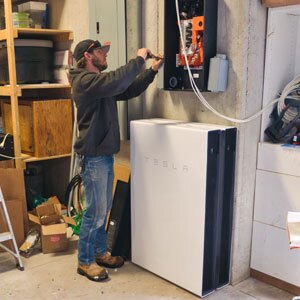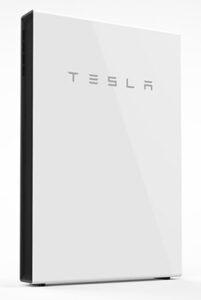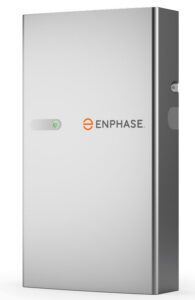UPDATE: We’ve posted a new solar battery comparison between the Tesal Powerwall 3, Enphase IQ 5P and Franklin aPower here.
One of the most common questions we are asked is “Should I install a battery with my solar panel system?” With rising concerns over power grid outages during extreme weather events, energy storage has become a more important piece of the solar puzzle. Here at Good Energy Solutions, we mainly install two different brands of solar batteries, Tesla and Enphase. Which battery makes the most sense for your situation? In this article, we’ll rundown the differences between both battery brands, including capabilities, availability and stacking.

A solar electrician installs two Tesla Powerwalls.
First let’s start with the basics of solar batteries. To put it simply, they store excess electricity generated by solar panels. That stored energy can power your home when your solar panels aren’t generating energy, including nights and cloudy days. They also can power your home when the power grid goes down.
It’s important to note that in most installations without a battery your home will not be able to utilize the electricity generated from your solar panels when the grid goes down. Because your solar panel system is wired into your electric company’s grid, they will stop producing energy if the power goes out for any reason. This is a safety mechanism that will allow the utility company’s workers to repair the lines during an outage without fear of being electrocuted. AC-coupled batteries like the Powerwall and Enphase IQ automatically disconnect your system from the grid when the power cuts out and use the solar panel system or battery bank to power your critical loads. This allows your solar panels or battery to operate as a code-compliant off-grid electrical system until the utility company can turn your power back on.
Another big selling point for solar batteries is the 30% federal solar tax credit, which you can apply towards the final price.
Tesla Powerwall vs Enphase IQ?
Let’s take a look at each battery and see how they stack up to each other. These two different batteries share a lot in common. Both are AC-coupled, which makes both easier to install into an existing solar panel system. The two batteries are designed to use primarily for emergency backup. Also, both feature simple-to-use apps that allow you monitor your home energy system in real time and make changes to the way they dispense power throughout the day.
Tesla Powerwall

The Tesla Powerwall 2 Battery
Tesla has designed this AC battery system for residential and light commercial use. It utilizes a lithium-ion battery that runs much quieter and cleaner than a conventional gasoline back-up generator. There’s no exposed vents that expel heat or visible wires making it a safer solution for households with kids or pets.
Tesla has three battery options: the Tesla Powerwall and Tesla Powerwall+ and the upcoming Tesla Powerwall 3. The batteries are pretty similar to one another — the difference is how they interact with your home’s energy system. The Powerwall is compatible with new and existing solar panel systems. It can also work as a stand-alone home battery without solar panels. On the other hand, the Powerwall+ battery is integrated with a Tesla Solar Inverter and must be installed with solar panels. Both Tesla batteries can be installed with other brands of solar panels. You don’t need Tesla solar panels to install a Powerwall. Information is limited at this point about the Powerwall 3 as Tesla won’t widely release their newest battery until sometime in 2024, although they have begun to roll them out to a few of their direct customers.
The Upside:
The Powerwall has become the biggest name in solar batteries since launching in 2015. It sports a sleek design and mounts nicely to the wall. Multiple Powerwalls can be stacked together to boost storage capacity and power more appliances throughout your home or business. Also, the Powerwall is one of the least expensive solar battery options on the market.
The Downside:
Its lower price has created a waitlist for the Powerwall. Depending on when you order one from Tesla, it could take months before your Powerwall arrives. Also, the Powerwall requires multiple electric boxes and additional parts to meet local electrical codes. These add-ons take up space, limiting your ability to work them into a workable design scheme while leaving you fewer options for concealment.
Here are the Powerwalls’ technical details:
| Tesla Powerwall 3 | Tesla Powerwall 2 | Tesla Powerwall (Discontinued) | |
| Usable capacity | 13.5 kWh | 13.5 kWh | 10 kWh |
| Round-trip efficiency | 97.5% | 92.5% | 92.5% |
| Depth of discharge | 100% | 100% | 100% |
| Continuous power output (on-grid) | 11.5 kW | 5.8 kW | 6.6 kW |
| Battery type | Lithium-ion | Lithium-ion | Lithium-ion |
| Size | 43.3″ H x 23.6″ W x 7.09″ D | 45.3″ H x 29.6″ W x 5.75″ D | 51.2″ H × 33.9″ W × 7.1″ D |
| Warranty | 10 years (expected) | 10 years | 10 years |
Enphase IQ

The Enphase IQ Battery 5P
Although they are one of the most recognizable brands in the solar industry for their line of microinverters, Enphase offers three different battery models. The IQ Battery 3 and IQ Battery 10 models take up less space than a PowerWall, but they also pack less power. Enphase also offers slimmer versions of these batteries with the 3T and 10T. The company’s newest solar battery option, the IQ Battery 5P, rivals the power output of larger batteries at half the capacity size.
Enphase has designed its line of batteries to be installed in bundles, creating a modular storage system where capacity and power output stack with each battery installed. This makes it easier to size a battery system for your specific needs. While you can stack the IQ Battery 3 and IQ Battery 10 together, the new IQ Battery 5P can only be stacked with similar 5P models.
Here are the IQs’ technical details:
| Enphase IQ Battery 3 | Enphase IQ Battery 10 | Enphase IQ Battery 5P | |
| Usable capacity | 3.36 kWh | 10.08 kWh | 4.96 kWh |
| Round-trip efficiency | 89% | 89% | 90% |
| Depth of discharge | 98% | 98% | 98% |
| Continuous power output (on-grid) | 1.28 kW | 3.84 kW | 3.84 kW |
| Battery type | Lithium iron phosphate | Lithium iron phosphate | Lithium iron phosphate |
| Size | 26.14″ H x 14.45″ W x 12.56″ D | 26.14″ H x 42.13″ W x 12.56″ D | 38.6″ H x 27.7″ W x 7.4″ D |
| Warranty | 10 years or 4,000 cycles | 10 years or 4,000 cycles | 15 years or 6,000 cycles |
The Upside:
Enphase is one of the most trusted companies in the solar industry. They back up their reputation with one of the best solar battery warranties on the market with 5P. Enphase IQ batteries can also be paired with gas-powered generators for extra backup protection and flexibility. The batteries’ lithium iron phosphate chemistry is safer and lasts longer than other competitors. Their smaller energy output comes with a lower cost, making them an excellent choice for backing up circuits that cover important smaller electronics like medical devices or sump pumps.
The Downside:
Enphase batteries have a lower power output individually than others on the market. These need to be stacked in order to provide enough backup protection for the biggest electrical appliances in your home.
Tesla Powerwall or Enphase IQ?
Several variables will factor into which battery will work best for your solar installation. Here at Good Energy Solutions, we stand behind both battery systems and see the benefits of adding either one to your energy plan. Our consultants can work with you to choose the right option for your solar installation based on price, power needs, maintenance and longevity. If you would like to talk with one of our solar consultants about battery backup systems for your home or business, contact us here.
SEE IF YOUR HOME OR BUSINESS IS A GOOD MATCH FOR SOLAR
GET A FREE QUOTE

